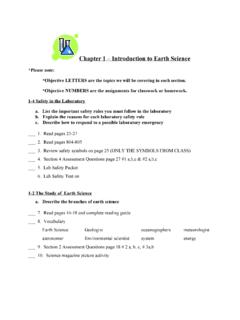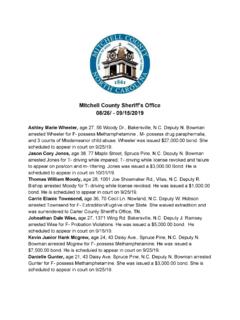Transcription of Simple and Complex Machines Simple and - chatham-nj.org
1 Simple and Complex Machines Simple and A Science A Z Physical Series Word Count: 1,230. Complex Machines Written by Ned Jensen Visit Simple and KEY ELEMENTS USED IN THIS BOOK. The Big Idea: Machines help us do work more quickly, easily, and/or safely. Machines reduce the amount of force required to do work but often require working over a greater distance. Seven types of Complex Simple Machines can be found in familiar devices. One or more Simple Machines may be combined to form a Complex machine. Understanding how various Machines work will help students to choose appropriate Machines and use them properly. Machines Key words: axle, block and tackle, Complex machine, distance, energy, first- class lever, force, friction, fulcrum, gear, hammer, inclined plane, knife, lever, lift, load, machine, pull, pulley, push, ramp, robot, screw, second-class lever, seesaw, Simple machine, slope, third-class lever, tool, turn, wedge, weight, wheel, wheel and axle, work Key comprehension skill: Cause and effect Other suitable comprehension skills: Compare and contrast; classify information.
2 Main idea and details; identify facts; elements of a genre; interpret graphs, charts, and diagrams; using a glossary and boldfaced terms; using a table of contents and headings Key reading strategy: Summarize Other suitable reading strategies: Ask and answer questions; connect to prior knowledge; visualize; retell Photo Credits: Front cover: Learning A Z; back cover: Steller; title page: ; page 3: ; page 4: Lazzari; page 5 (left): ; page 7 (top left): Manley; page 7 (top right): Padovani;. page 7 (center left): Barsse; page 7 (center right): Cenk Ertekin; page 7 (bottom left): Fensom; page 7 (bottom center): Jurica; page 7 (bottom right): Massimiliano Leban/123RF; page 8: Jupiterimages Corporation; page 9 (top): Bettmann/Corbis; page 9 (bottom): Duncan Astbury; page 10 (top left): Subbotin; page 10 (top right): Burnett; page 10 (bottom): Christopher Meder/123RF; page 11: Mart nez Ban s; page 13 (top left): Sergey Lavrentev/123RF; page 13 (bottom left): Monkey Business ; page 13 (right): Ben Conlan; page 14 (left): Albrektsen; page 14 (right): Christophe Testi/.
3 ; page 15 (top): ; page 15 (bottom): Courtesy Dr. Anton Velu c ek; page 16: Alexey ; page 18 (left): Goerg; page 18 (right): White; page 20 (gear): Murray; page 21 (left): Brutlag; page 21 (right): Wojtek Kryczka; page 22 (right): NASA/Science Source/Photo Researchers, Inc. Illustration Credits: pages 6, 12, 17: Cende Hill; pages 19, 20 (except gear): Casey Jones Written by Ned Jensen Simple and Complex Machines Learning A Z, Inc. Written by Ned Jensen All rights reserved. Table of Contents Introduction .. 4. Types of Simple Machines .. 7 Introduction Inclined Plane .. 8 How do you do work? How do you Wedge .. 9 eat cereal or loosen the lid of a jar? Screw .. 10 You probably use tools. 11. Wheel and Axle .. 14 Tools make work easier to do. A machine Gear .. 16 is a device that uses energy to do work. Pulley .. 17 Tools that have only a few parts are called Simple Machines .
4 A hammer Simple Machine 19. is a Simple machine. Some Machines Complex Machines .. 21. combine several Simple Machines . Conclusion .. 22. Clocks and bicycles are Complex Glossary .. 23 Machines . In this book, you will learn Index .. 24 how Machines make work easier. 3 4. Animals use tools, too! Apes use sticks to get ants out of anthills. Sea otters use rocks to crack open clamshells. Crows can make wire hooks to get food out of a tall, thin container. What do we mean by work? In science, work means moving something. To move something, you use force. The more force it takes to move an object, the more work is done. The more Both ramps do the same amount of work. The top ramp requires distance something moves, the more twice as much force as the bottom ramp, but the bottom ramp covers twice as much distance. Which ramp would you rather use? work is done.
5 Machines make work easier by reducing Whenever you push, pull, turn, or lift the amount of force it takes to move an an object, you use force. The amount object, or load. of force it takes depends on how heavy the object is. It takes a lot more force But there is a trade-off. Machines make to move a big rock than to move a your work easier, but you have to work small rock. over a longer distance. 5 6. Types of Simple Machines 250-pound refrigerator There are only a few types of Simple 175-pound force Machines . Some have no moving parts. Some have just a few moving parts. Below are the seven Simple Machines you will read about in this book. Inclined Plane The inclined plane is a very Simple machine. It is a surface with a slope, or incline. Inclined planes help us change Inclined plane Wedge the height of heavy objects. A common inclined plane is a ramp.
6 Furniture movers use ramps. It is easier to slide a heavy box up a ramp than it is Gear Lever to lift the box straight up. Moving the box up the slope of a ramp takes less force. The longer the ramp is and the gentler its slope, the less force it takes to move a box up it. But remember the trade-off. The gentler and longer the slope, the Wheel and axle Screw Pulley farther you have to push or pull the load. 7 8. inclined Over 3,000 years ago, plane the Egyptians used inclined planes to build pyramids. They used long ramps to move heavy stones uphill. An inclined plane wraps around the center of a screw. As the screw Wedge turns, it moves into the object. A wedge is really just two inclined planes Screw that meet. A wedge helps you push things apart. The blade of a knife is a A screw is an inclined plane wrapped wedge. Your front teeth are also wedges. around a rod.
7 The thread on a screw is Wedges cut the inclined plane. As you turn a screw, WEDGE. through things the thread forces the screw into wood or by moving them metal. Screws usually hold two things apart. The together, such narrower the as two pieces wedge, inclined of wood. They plane the easier it is to inclined can also move plane move things things by pushing apart. them along using the thread. A wedge can split a piece of wood. Screws hold things together. 9 10. Lever A lever is a machine that can move heavy things. A lever often has two parts. One part is a board or bar. The board rests on a point called the fulcrum. The board When the fulcrum is close to an object, the object can be lifted more easily but not as high. pivots, or turns, on the fulcrum. If you want to use a lever to lift something, place the thing on one part of the lever. Then push on another part of the lever.
8 If you've ever been on a seesaw, you've used a lever. On a seesaw, you can With the fulcrum far away from an object, the object is harder to lift, but it can be lifted higher. balance with someone much heavier than you. You sit far from the fulcrum, and the A fulcrum can be put anywhere along heavier person sits close to the fulcrum. a lever, not just in the center. Changing where the fulcrum is can make your job LEVER. heavier weight easier. The closer the object is to the lighter weight fulcrum, the easier it is to move. The farther the force is from the fulcrum, bar fulcrum the easier it is to move the object. In the diagram above, the top lever requires half as much force as the bottom one does. 11 12. There are several ways to set up a lever. more distance wheel The fulcrum can be between the force less distance and the object, as in a seesaw. Or the object can be between the force and the axle fulcrum.
9 A wheelbarrow is an example. wheel axle A wheel turns farther than the axle, but with less force. The force can also be between the fulcrum and the object. First-Class Lever Third-Class Lever Wheel and Axle object A wheel and axle is another Simple object machine. It is made of a wheel that force force is attached to a rodlike axle. When the wheel turns, the axle also turns. fulcrum fulcrum The wheel is wider than the axle. When a force turns the wheel, the force Second-Class Lever transfers to the axle. The wheel turns a greater distance with less force. The object force axle turns a lesser distance with more force, so it can move heavy objects. A. fulcrum doorknob is a wheel and axle. It makes opening a door easier. Wheels and axles Moving the fulcrum and object on a lever can help you do different things. are used in cars and bicycles. 13 14. Wheels reduce the amount of friction between things.
10 Friction is a force that happens A wagon with wheels whenever two creates less friction than a wagon without wheels. surfaces rub against each other. It makes it harder to move an object. The more surface that rubs together between objects, the more For every time the large gear turns, the small gear turns more than once. The large gear has more force, while the small friction there is. The more friction there gear moves faster. is, the harder it is to move the objects Gear past each other. A wheel only has one small part touching the ground at any A gear is really just a wheel with teeth. time, causing friction. Without wheels, Gears transfer force from one place to there would be a lot more friction another. Gears are attached to axles. between a wagon and the ground. They can increase or decrease an object's speed or change the amount of force needed to move it.




